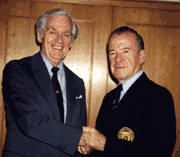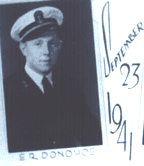Tracking the Hunters, the Hunted
by George Duffy
If you are not a student of the history of World War II, and in particular, the subject of submarine warfare, the name Clay Blair Jr. will not ring a bell.
The author of hundreds of magazine articles and 24 books, Mr. Blair, unlike many historians, actually saw combat in World War II making two patrols into Japanese waters in the USS Guardfish (SS-217). Following the war he embarked on a career in journalism which led to positions with Time-Life and The Saturday Evening Post. He eventually became editor-in-chief of the latter.
Frankly, Blair did not come to my attention until his Silent Victory hit the bookstores almost 25 years ago. This marvelous, 1,072-page tome is the definitive history of the United States Navy submarine service from Dec. 7, 1941 to the Japanese surrender ceremony on board the USS Missouri on Sept. 2, 1945.
With the exception of about 100 introductory pages and 180 pages of appendixes, Silent Victory is a chronological saga -- victories and defeats, successes and humiliations -- relating to a phase of World War II of which I knew very little.
By that time Blair had terminated his magazine career in favor of becoming a free-lance author. Following Silent Victory by about four years came Return From the River Kwai co-authored by his wife Joan. On September 4, 1944, according to the Blairs, 2,218 British and Australian soldiers, who as prisoners of the Japanese had built a railway through Burma and Thailand, left Singapore's River Valley POW camp for two Japan-bound ships.
On the 11th, both were torpedoed. The American submarines that did the deed managed to pick up 159 survivors, of whom 152 lived to be hospitalized in Guam. Another 656 were saved by Japanese escort vessels. These men eventually reached Moji, Japan, on September 29, 1944 where about 50 died before the war's end.
Although I personally knew none of the original 2,218, our paths had crossed. According to my journal I arrived in Singapore on July 1, and was put into River Valley Camp which I described as being "in a bad state." In their book, the Blairs quote the Australians and British, who had all worked for many months on the infamous railway, as saying "River Valley camp was one of the worst they had ever seen." Strange, isn't it, that I never knew the fate of those prisoners until I read Return From the River Kwai.
Blair wrote an additional three books and then effectively disappeared until 1996 when Hitler's U-Boat War: The Hunters. 1939-1942 was published by Random House. This was followed two years later by Hitler's U-Boat War: The Hunted. 1942-1945. At 909 and 809 pages respectively, they are the product of 11 years of intense research. And what an enormous treasure trove resulted.
I made a trip from Australia to Boston via Panama in March 1942, and went to Trinidad from New York on the way to the Persian Gulf in April. Other than sighting what could have been a U-boat on the horizon astern of us one evening, we saw nothing that could have been the enemy.
Everywhere on the ocean, though, there was floating, unidentifiable debris, positive evidence of what no one in authority would admit. The German Navy was wreaking havoc from Newfoundland to Brazil, and doing it virtually unopposed.
[Type VII U-Boat from Hitler's U-Boat War: The Hunters, 1939-1942, Clay Blair, New York: Random House, 1996]
Blair spells it out:

